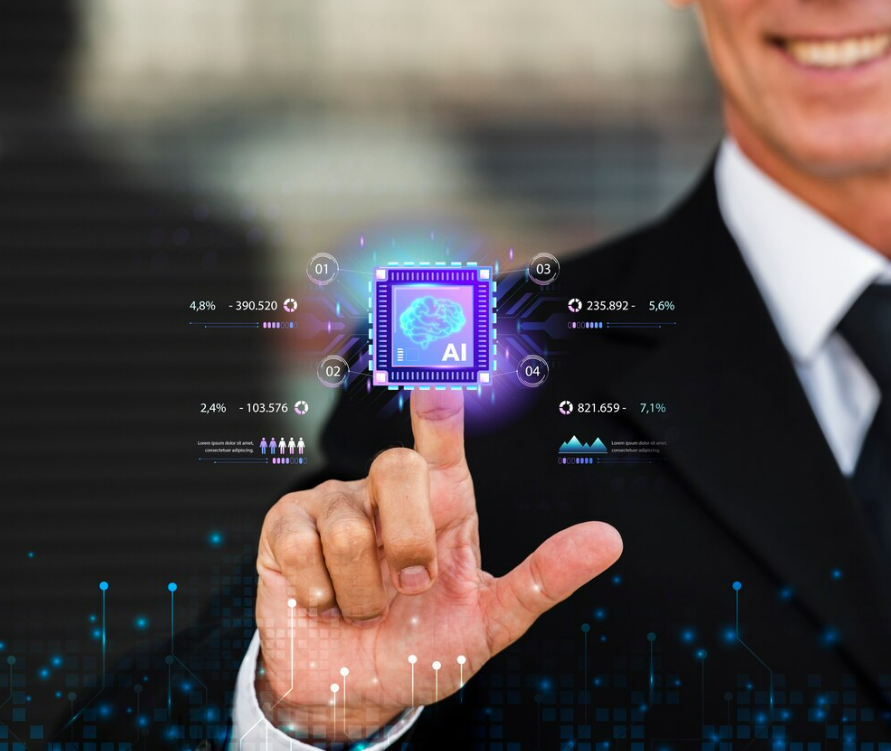How Can Artificial Intelligence Help In Governance?

In a world driven by data and demanding efficient solutions, governments face mounting pressure to streamline their operations and deliver effective services. Traditional methods are often bogged down by inefficiencies, resource constraints, and a disconnect between citizens and their needs. Here’s where Artificial Intelligence (AI) bursts onto the scene, offering a paradigm shift in how governments can function. This blog dives into the transformative potential of AI, showcasing how intelligent solutions are reshaping government operations for a better future.

Data-Driven Decisions and Automation: AI’s Impact on the Future of Government Work
Setting the Stage:The Labyrinth of Modern Governance
Governments today navigate a complex maze of challenges. Resource limitations are a constant hurdle, as tighter budgets and shrinking personnel make delivering on ambitious public mandates seem like an uphill battle. Citizen demands are ever-evolving, with expectations for transparent, swift, and personalized services growing louder. Meanwhile, a data deluge engulfs government agencies, overflowing with valuable insights yet lacking the capacity to unlock their full potential. This perfect storm of scarcity, demand, and unharnessed information leaves governments struggling to keep pace with the needs of their constituents.
The Dawn of AI: A Beacon of Hope in the Maze
In the midst of this intricate landscape, Artificial Intelligence (AI) emerges as a beacon of hope. Like a skilled navigator, AI offers a map and compass to navigate the labyrinth. Its potential to transform government operations shines brightly, promising efficiency, effectiveness, and a shift towards citizen-centricity.
Demystifying the AI Enigma:Deciphering the AI Alphabet Soup
To truly understand AI’s transformative power, it’s crucial to demystify its jargon. At its core, AI is about empowering machines to learn and adapt without explicit programming. This magic is fueled by powerful tools like machine learning, which allows AI to learn from data and improve its performance over time. Natural language processing acts as a translator, enabling AI to understand and respond to human language, while data analytics equips it with the power to sift through mountains of information, extracting insights and patterns invisible to the human eye.
Beyond the Hype: Building Trust in the AI Age
The allure of AI is undeniable, but concerns around its ethical implications and potential misuse linger. Addressing these concerns head-on is critical to building trust and ensuring responsible adoption. Openness and transparency in AI development processes, robust ethical frameworks, and safeguards against bias and discrimination are keystones in forging a future where AI empowers, rather than undermines, our values.
Transforming Government Operations with AI
Operational Efficiency: Unleashing the Power of Intelligence
Streamlining Administrative Tasks
Intelligent data entry: Eliminate manual data entry errors with Optical Character Recognition (OCR) and Natural Language Processing (NLP) that automatically extract data from forms and documents.
AI-powered document processing: Classify, categorize, and route documents instantly, reducing processing time and manual effort. This includes:
Automating approvals: AI-powered workflows can analyze data and documents to pre-approve routine applications, freeing up human reviewers for complex cases.
Fraud detection and risk management: Algorithmic analysis can identify patterns and anomalies in financial transactions, contracts, and other documents to prevent fraud and mismanagement.
Predictive Maintenance: From Reactive to Proactive
Monitoring infrastructure health: Sensors embedded in bridges, roads, and buildings can provide real-time data on their condition. AI can analyze this data to predict potential failures and schedule preventive maintenance, saving costs and avoiding disruptions.
Optimizing resource allocation: By analyzing energy consumption patterns and weather data, AI can optimize lighting schedules, heating/cooling systems, and power distribution in government buildings, leading to significant energy savings.
Automating Routine Processes: Freeing Human Potential
Chatbots and virtual assistants: 24/7 intelligent assistants can handle basic inquiries, schedule appointments, and provide information, freeing up human staff for more complex interactions.
Automated reporting and data analysis: Generate reports, analyze trends, and identify actionable insights from government data automatically, streamlining data-driven decision making.
Automated tax filing and benefits applications: AI can help citizens navigate complex forms and automate filing processes, improving accuracy and efficiency.
Additional Potential:
Cybersecurity: AI-powered threat detection and incident response can protect government systems from cyberattacks.
Public communication: AI can personalize communication with citizens, send targeted alerts and updates, and improve public engagement.
Translation and accessibility: AI-powered translation tools can improve communication with diverse populations and provide equal access to government services.
By implementing these AI-powered solutions, governments can:
Reduce administrative costs and improve resource allocation.
Increase efficiency and accuracy in core government functions.
Enhance citizen satisfaction and access to services.
Shift from reactive to proactive decision-making, improving infrastructure resilience and public safety.
Enhanced Service Delivery: Revolutionizing Citizen Interaction with AI
Beyond streamlining internal processes, AI has the potential to revolutionize how governments interact with citizens, delivering personalized, 24/7 services and proactively addressing their needs. Here’s a deeper dive into three key areas of transformation.
Intelligent Chatbots and Virtual Assistants
Beyond FAQs: Move from scripted interactions to AI-powered virtual assistants that understand natural language and context, able to:
Answer complex questions about permits, grants, social services, and more.
Guide citizens through multi-step processes, offering personalized instructions and assistance.
Schedule appointments, submit forms, and handle basic transactions, reducing wait times and frustration.
Learn from each interaction, becoming more accurate and helpful over time.
24/7 Accessibility: Provide information and support around the clock, regardless of location or language barriers.
Multilingual Capabilities: Break down language barriers and serve diverse communities by offering chatbot assistance in multiple languages.
Human-in-the-Loop Option: Ensure seamless transitions to human agents for complex issues or sensitive cases.
Personalized Citizen Services
Leveraging Data for Tailored Experiences: Analyze citizen data (with proper consent and security measures) to personalize services such as:
Recommending relevant social assistance programs based on individual needs.
Providing targeted educational resources and career guidance.
Offering preventive healthcare tips and early intervention programs based on health risks.
Streamlining tax filing and benefit applications with pre-populated data.
Predictive Outreach: Anticipate citizen needs and proactively offer support before they arise. For example:
Sending birthday reminders for important documents or renewals.
Reaching out to vulnerable populations potentially facing food insecurity or financial hardship.
Alerting parents about upcoming vaccination schedules or educational opportunities.
Proactive Outreach and Engagement
Sentiment Analysis and Social Listening: Monitor social media and other online platforms to identify citizen concerns and needs.
Address public grievances on issues like infrastructure problems, transportation disruptions, or safety concerns.
Gauge public opinion on policy proposals and gather feedback during consultation processes.
Targeted Communication and Alerts: Use data and AI to segment citizens based on interests and needs, then send targeted communications such as:
Emergency notifications and evacuation alerts during natural disasters.
Public health advisories and vaccination campaigns.
Community updates and event announcements relevant to specific neighborhoods or demographics.
These are just a few examples of how AI can be used to transform citizen service delivery. By harnessing the power of intelligent technology, governments can create a more responsive, personalized, and proactive experience for their citizens, building trust and fostering a more engaged community.
Remember, the key to success lies in responsible AI development, ensuring:
Transparency and Explainability: Citizens should understand how AI decisions are made.
Data Privacy and Security: Protecting sensitive citizen data is paramount.
Human Oversight and Accountability: Humans must remain in control and accountable for AI’s actions.
Data-Driven Policymaking: Leveraging AI for Smarter, More Effective Governance
Traditional policymaking often relies on intuition, historical trends, and expert opinions. While valuable, these methods can be limited in their scope and ability to predict real-world outcomes. This is where AI enters the scene, armed with powerful data analysis and modeling capabilities. Let’s delve deeper into how AI is changing the game in data-driven policymaking.
Analysing Vast Data Sets
Unveiling Hidden Patterns: Imagine sifting through millions of citizen records, social media posts, and sensor data to identify hidden patterns and correlations. AI algorithms can do just that, uncovering trends in crime rates, healthcare disparities, or economic fluctuations. This reveals previously invisible factors influencing policy decisions.
Predicting Future Outcomes: By analyzing historical data and current trends, AI can model potential impacts of proposed policies. This proactive approach allows policymakers to identify potential negative consequences, like economic downturns or increased pollution, and adjust their strategies accordingly.
Targeted Interventions: Instead of one-size-fits-all policies, AI can help pinpoint specific populations or geographic areas most affected by an issue. This enables policymakers to tailor interventions for maximum impact, delivering targeted solutions instead of broad-brush approaches.
Simulating Policy Scenarios
Testing the Waters: No longer do decisions have to be made in a vacuum. AI-powered simulations allow policymakers to test the potential effects of different policy options in a virtual environment. This helps assess the effectiveness of interventions, compare costs and benefits, and identify unintended consequences before implementation.
Real-Time Adjustments: As real-world data pours in, AI models can continuously update simulations, allowing for on-the-fly adjustments and policy fine-tuning. This adaptability ensures policies remain relevant and responsive to changing circumstances.
Collaboration and Stakeholder Engagement: Simulations can be shared with diverse stakeholders, from citizens and businesses to NGOs and experts. This collaborative approach fosters transparency, builds trust, and allows for valuable feedback before policies are finalized.
Evidence-Based Decision-Making
Facts, not Fallacies: Instead of relying on unsubstantiated claims or political ideologies, AI provides a foundation of concrete evidence for policy decisions. Data-driven insights inform objective and transparent choices, minimizing biases and promoting accountable governance.
Measuring Impact and Progress: Monitoring the real-world effects of policies is crucial for continuous improvement. AI can track key metrics and evaluate the success of implemented policies, helping identify areas for improvement and adjust future strategies.
Long-Term Planning: By analyzing long-term trends and potential future scenarios, AI can inform sustainable and forward-thinking policies. This helps governments prepare for future challenges, like climate change or demographic shifts, ensuring long-term stability and prosperity.

Case Studies: AI in Action
Healthcare
AI-powered diagnostics
Dermatology: AI algorithms analyze skin lesions, aiding in early detection of melanoma and other skin cancers.
Radiology: AI assists doctors in reviewing X-rays, CT scans, and MRIs, flagging potential abnormalities with high accuracy.
Ophthalmology: AI identifies diabetic retinopathy and age-related macular degeneration in eye scans, facilitating timely intervention.
Patient management systems
Predictive analytics: AI algorithms forecast individual patient risk for infections, chronic diseases, and hospital readmissions, enabling proactive preventive care.
Virtual assistants: AI-powered chatbots answer patient queries, schedule appointments, and provide 24/7 health information and symptom checking.
Personalized treatment plans: AI analyzes patient data and medical history to recommend personalized treatment options, optimizing care outcomes.
Fraud detection: AI identifies patterns in insurance claims and healthcare spending data, preventing fraudulent activity and safeguarding public funds.
Education
Adaptive learning platforms: AI tailors learning materials and exercises to individual student needs and learning pace, fostering personalized education and improved knowledge retention.
Personalized feedback: AI provides immediate and real-time feedback on student work, identifying areas of difficulty and offering targeted guidance for improvement.
Automated grading: AI assists teachers in grading essays, multiple-choice quizzes, and other assessments, freeing up time for individualized student support and instruction.
Early intervention and support: AI algorithms analyze student data to identify students at risk of academic failure or learning disabilities, allowing for early intervention and targeted support programs.
Environmental Management
Pollution monitoring: AI-powered sensors and drones collect real-time data on air and water quality, allowing for quick identification and mitigation of pollution sources.
Predicting natural disasters: AI models analyze weather patterns and environmental data to predict floods, wildfires, and other natural disasters, enabling proactive emergency response and evacuation efforts.
Optimizing resource consumption: AI analyzes energy usage in buildings and infrastructure, providing recommendations for reducing consumption and minimizing environmental impact.
Precision agriculture: AI analyzes soil, crop, and weather data to optimize irrigation, fertilization, and pest control, increasing agricultural efficiency and reducing environmental footprint.
Public Safety
Crime prediction and prevention: AI analyzes historical crime data and identifies patterns to predict high-crime areas and potential criminal activity, enabling targeted deployment of police resources.
Traffic management: AI-powered traffic cameras and sensors monitor traffic flow in real-time, optimizing traffic lights and providing dynamic route guidance to reduce congestion and improve safety.
Emergency response optimization: AI models analyze emergency call data and traffic conditions to direct first responders to incidents efficiently, minimizing response times and saving lives.
Predictive maintenance: AI algorithms analyze data from police vehicles, fire trucks, and other public safety equipment to predict potential maintenance issues and prevent breakdowns, ensuring operational readiness.

Expanding and Elaborating on the Challenges of AI in Government
Ethical Implications
Bias: AI algorithms can inherit and amplify biases present in the data they are trained on. This can lead to discriminatory outcomes, such as unfair hiring practices, biased loan approvals, or inaccurate criminal profiling. To mitigate this, governments must:
Use diverse and representative data sets: Ensure training data reflects the population it serves.
Implement fairness audits: Regularly assess algorithms for potential bias and implement corrective measures.
Establish clear ethical guidelines: Develop frameworks for responsible AI development and deployment, with a focus on fairness, transparency, and accountability.
Transparency and Explainability: AI decision-making can be opaque, making it difficult to understand how and why certain outcomes occur. This lack of transparency can erode trust in government and lead to accusations of unfairness. To address this, governments should:
Develop explainable AI models: Invest in research and development of AI models that can explain their reasoning and decision-making processes.
Publish clear communication protocols: When using AI, provide citizens with clear explanations of how it works and how it impacts them.
Enable human oversight: Maintain human oversight and control over AI systems, ensuring they are used responsibly and ethically.
Accountability: When AI systems make mistakes or cause harm, it’s crucial to determine who is accountable. This can be complex, as responsibility may lie with the developers, the government officials who implement the system, or even the algorithm itself. To address this, governments should:
Establish clear lines of accountability: Define who is responsible for different aspects of AI development, deployment, and use.
Develop mechanisms for redress: Ensure citizens have avenues to appeal or challenge decisions made by AI systems.
Promote continuous learning and improvement: Implement feedback loops to identify and address problems with AI systems, ensuring they continue to serve the public good.
Data Security and Privacy
Protecting Sensitive Data: Government agencies hold vast amounts of sensitive citizen data, including social security numbers, medical records, and financial information. Implementing robust cybersecurity measures is crucial to protect this data from breaches, leaks, and unauthorized access. This includes:
Data encryption: Encrypting data at rest and in transit to prevent unauthorized access.
Access controls: Implementing strict access controls to limit who can access sensitive data.
Regular security audits: Conducting regular security audits to identify and address vulnerabilities in systems.
Responsible AI Development: The development and deployment of AI systems should be done responsibly, with a focus on protecting citizen privacy. This includes:
Data minimization: Collecting and storing only the minimum amount of data necessary for the intended purpose.
De-identification: When possible, anonymize or de-identify data to protect individual privacy.
Transparency about data use: Inform citizens about how their data is being used and collected through AI systems.
Public Trust and Legitimacy: Building public trust and legitimacy is crucial for the successful implementation of AI in government. This can be achieved by:
Openness and transparency: Engaging in open dialogue with citizens about AI, explaining its potential benefits and risks.
Public education: Educating citizens about AI and its implications for their lives.
Community involvement: Involving citizens in the development and deployment of AI systems to ensure they meet their needs and concerns.
Workforce Transformation
Preparing for AI-enabled Jobs: AI will automate many existing tasks, leading to job displacement in some sectors. Governments must prepare for this by:
Reskilling and upskilling initiatives: Investing in training programs to equip workers with the skills needed for AI-enabled jobs.
Career guidance and support: Providing career guidance and support to help workers transition to new roles.
Safety nets and social programs: Implementing safety nets and social programs to support those who are displaced by AI.
The Role of Public Servants: Public servants will need to adapt to working alongside AI systems. This will involve:
Developing new skills: Learning how to work with and interpret AI outputs.
Focusing on high-value tasks: Focusing on tasks that require human judgment, creativity, and empathy, which AI cannot replicate.
Human-AI collaboration: Building effective partnerships between humans and AI to achieve optimal outcomes.
The Future of Work: The impact of AI on the future of work is still uncertain. Governments should:
Monitor and research the impact of AI: Continuously monitor and research the impact of AI on the workforce to inform policy decisions.
Promote a human-centered approach: Ensure that AI is used to augment human capabilities and create a more fulfilling work experience for all.
Conclusion
Navigating the AI landscape for governments isn’t a smooth silicon path, but a tightrope walk between progress and prudence. Embracing AI responsibly demands transparency, inclusivity, and proactive foresight. Open dialogue with citizens, robust ethical frameworks, and addressing bias and privacy concerns are the first steps on this journey. But AI isn’t a magic bullet; it’s a tool, and its effectiveness depends on the hands that wield it. Human-centered design is the guiding light, ensuring AI amplifies, not replaces, the human touch. User-friendly interfaces, accessibility for all, and mechanisms for human oversight keep AI in its rightful place: alongside humanity, not above it.
By embracing AI responsibly and prioritizing human-centered design, governments can unlock a future of staggering potential. Imagine a government that anticipates your needs – AI-powered systems flagging potholes before they erupt or predicting floods before they devastate. Multilingual chatbots and natural language processing break down communication barriers, ensuring everyone feels heard and understood. AI-powered feedback loops continuously improve service delivery, tailoring solutions to individual needs and evolving alongside our expectations. This isn’t science fiction; it’s a tangible future within reach. By embracing AI’s transformative potential responsibly, governments can build a future of efficient, effective, and citizen-centric services, fostering a society where technology empowers rather than disenfranchises, and progress serves all. This future rests on a foundation of proactive ethics, human-centered design, and constant dialogue. The call to action is clear: let’s build this future together, brick by ethical brick, line by empathetic line of code.





